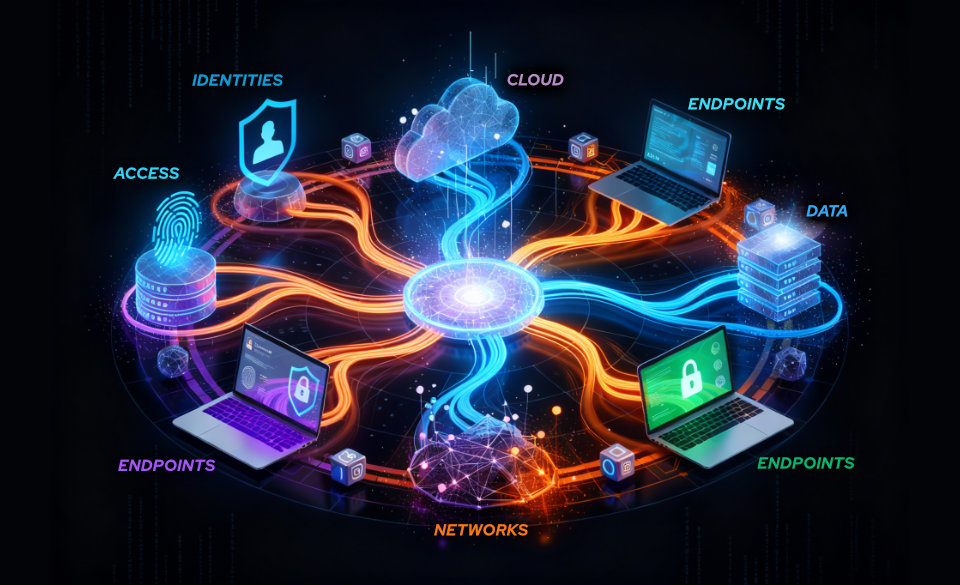
Network Segmentation: The Art of Dividing to Protect
24 de April de 2025
RBAC vs ABAC in Cybersecurity: Which is more secure and when to use each?
8 de May de 2025Redefining the Perimeter in the Post-Firewall Era
For decades, enterprise network architecture was built on a simple premise: the perimeter exists and can be protected. It was enough to physically delimit the internal network, filter external traffic through firewalls, and apply basic access controls to users. This model assumed implicit trust in everything “inside” the corporate environment and was based on a topological, static, and closed view of IT infrastructure. Today, this approach has become obsolete, giving way to perimeter connection cybersecurity.
Massive virtualization, the adoption of cloud computing, the proliferation of IoT devices, the rise of remote work, service outsourcing, and the convergence of IT and OT networks have shattered that perimeter. The network is no longer a confined space but a dynamic and distributed ecosystem, where the connection point becomes the new security perimeter.
In this scenario, cybersecurity is no longer about protecting the physical network, but about contextually defending every connection that tries to interact with an organization’s critical systems. Every remote session, API access, VPN tunnel, SSH or RDP command represents a potential entry point into the enterprise environment. What’s at stake is not just access to information, but the operational continuity of industrial systems, data centers, telecom platforms, or national infrastructure.
What Is Perimeter Connection Cybersecurity?
The concept of connection perimeter is the evolution of the old network perimeter. Whereas security used to revolve around a defined physical and logical infrastructure, it now focuses on the points from which communications are initiated towards organizational assets—be they users, systems, devices, or automated processes.
Perimeter connection cybersecurity includes:
- Remote administrative interfaces (RDP, SSH, TELNET, VNC, WebGUI)
- Access to internal networks via VPN or ZTNA
- Links to IoT devices or industrial systems (PLC, SCADA, sensors, IP/serial gateways)
- External systems integrated via API
- Vendor connections for maintenance or support
- Tunnels or links to data centers, public clouds, hybrid or edge environments
- Access via user-owned or roaming devices (BYOD)
- Remote monitoring or management systems
Each of these points represents a transition between two control domains: the corporate environment (trusted) and an external origin (uncontrolled). It is at these intersections that the smartest and most robust defenses must be deployed.
The Invisible Threat: What Happens When the Connection Perimeter Is Not Protected
Most modern attacks do not begin with a firewall breach but with abuse of legitimate access. A classic example is the use of stolen or weak credentials to establish an RDP session with a vulnerable server or the exploitation of an exposed API without strong authentication mechanisms to extract or modify sensitive data.
Additionally, OT systems or embedded devices (such as antennas, routers, sensors, valves, or actuators) often lack native protection capabilities, making them extremely fragile access points. Many use insecure protocols by design, without encryption or authentication, and their web admin interfaces are often accessible from the corporate network or, worse, from the Internet.
Another rising risk is the persistence of legacy configurations where obsolete protocols like TELNET, FTP, or HTTP remain active for compatibility, allowing attackers to intercept traffic, capture credentials, or execute commands with ease.
When the connection perimeter is not protected, the consequences include:
- Silent privilege escalation
- Lateral movement between IT and OT networks
- Access to SCADA systems without human oversight
- Disruption of production or industrial processes
- Encryption of critical assets via ransomware
- Undetected exfiltration of operational information
The cost of an uncontrolled breach is not measured in bytes, but in operational downtime, reputational damage, and legal consequences.
Modern Perimeter Connection Cybersecurity: Contextual, Segmented, and Persistent Defense
Protecting this new perimeter requires a radically different approach: the goal is not to protect the edge of the network, but each connection attempt. This is achieved through advanced technologies and principles that form a dynamic and adaptive defense:
1. Zero Trust and Continuous Verification
Instead of assuming default trust, the Zero Trust model requires validating each user, device, context, and request before granting access. Multifactor authentication (MFA), dynamic policy engines, and contextual analysis systems (geolocation, behavior, time of day, device reputation) are key components.
2. Network Microsegmentation
This enables the creation of logical security zones where the principle of least privilege is applied. An industrial system can only communicate with the control server it needs—not the entire network—dramatically reducing lateral movement and isolating compromises.
3. Remote Access Control with Session Recording
Every session initiated by remote technicians, vendors, or administrators should go through an intermediary system that manages, audits, and records all activity. This is achieved through bastion solutions or hardened remote desktops, such as the one integrated in Endurance.
Through this mechanism:
- The asset is never directly exposed to the user.
- Only encrypted input/output events are transmitted (mouse, keyboard, video, audio).
- The entire session is recorded with detailed logs and high-resolution video.
- Clipboard use, screenshots, or unauthorized transfers are blocked.
- Granular rules can be applied (schedules, session duration, authorized devices, etc.).
4. Protection of Administration Interfaces
Web interfaces of routers, PLCs, antennas, IoT nodes, or servers must always be isolated through secure jumps, never exposed directly. This prevents brute-force attacks, automated scans, and zero-day exploits.
Endurance’s Unique Value in Protecting the Connection Perimeter
At Cosmikal, we understand that the modern perimeter is protected from the inside out—not the other way around. That’s why our Endurance solution is built on a PAM + bastion + hardened virtualized connection model, with an exclusive additional security layer:
- Only a virtualized graphical interface is transmitted. Nothing from the target system is exposed or transferred unless explicitly allowed.
- No port openings are required on assets or industrial networks.
- Sessions are controlled from a centralized orchestrator, managing access without direct user involvement.
- The user never knows the IP, credentials, or location of the asset—and in many cases, not even the OS behind it.
- Integrates with identity systems, active directories, MFA, and ticketing tools, enabling full traceability.
This makes Endurance an active and dynamic shield for every connection initiated toward the organization’s critical assets.
Conclusion: A Secure Connection Is One You Control
Modern cybersecurity is not about locking doors but about knowing who’s coming in, how they enter, what they access, and what they do during the session. The perimeter is no longer about firewalls and DMZs, but about smart decisions for every connection attempt.
That’s why protecting the connection perimeter is not optional—it’s strategic. And doing it with advanced solutions like Endurance means turning weak points into digital strongholds.
Because in a world where work, production, and connectivity never stop, the most secure connection is the one you control—how, when, and under what conditions it’s allowed.




